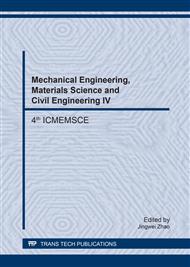p.309
p.313
p.318
p.323
p.330
p.335
p.340
p.345
p.350
Study on the Interfacial Binding Energy of Plasma Sprayed FeSi Nano-Composite Coating
Abstract:
Plasma sprayed FeSi nanocomposite coating is used more and more widely, yet the cohesive force in nanocomposite coating on mild steel is still a problem to solve. This paper aimed to use MM simulation to estimate the cohesive strength. To simulate the interfacial binding energy in plasma sprayed FeSi nanocomposite coating on mild steel, different kinds of FeSi-Fe molecular models were built. The simulation results indicated that the mild steel supporting plasma sprayed FeSi nanocomposite coating showed a higher cohesive strength with moderate thickness and thermal treated of FeSi. In the system of FeSi-Fe, the separation will take place between FeSi and Fe layer, the best thickness of plasma sprayed FeSi nanocomposite coating is about 6μm, and thermal treated under hydrogen atmosphere is about 1400K. The results of MM simulation provide some theoretical basis for preparation of plasma sprayed FeSi nanocomposite coating on mild steel with advanced cohesive strength.
Info:
Periodical:
Pages:
330-334
Citation:
Online since:
March 2017
Authors:
Price:
Сopyright:
© 2017 Trans Tech Publications Ltd. All Rights Reserved
Share:
Citation:


